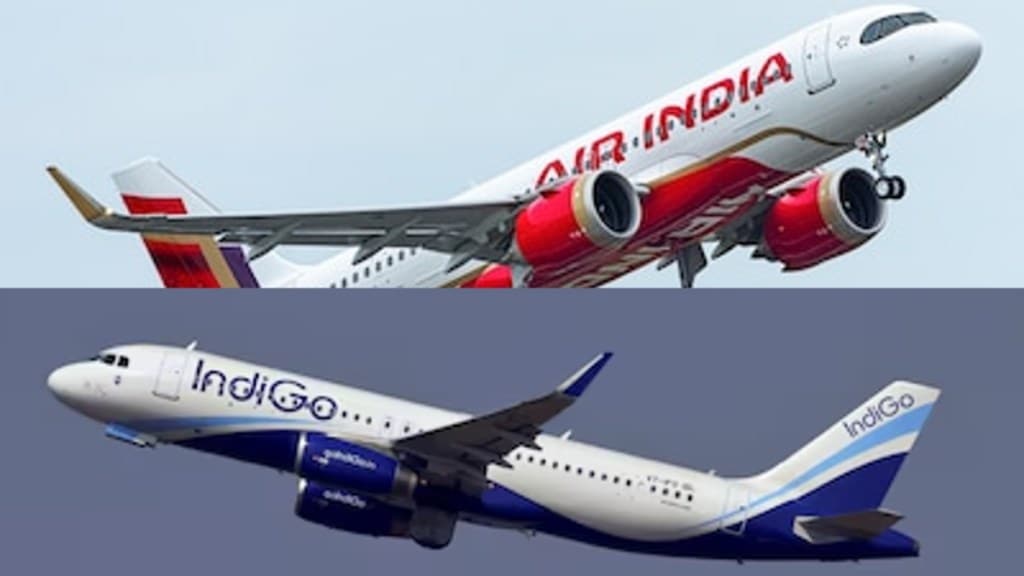The Indian aviation sector is witnessing an intense battle between two giants—IndiGo, the market leader in the low-cost carrier (LCC) segment, and Air India, the reemerging full-service carrier under the Tata Group. The competition has reached a critical juncture as both airlines adapt to evolving market demands and vie for dominance in key routes and passenger segments.
As IndiGo’s flight 6E-6814 took off for Mumbai from Delhi, a significant chapter in Indian aviation unfolded. The launch of IndiGoStretch, a dual-class product, marks a historic milestone for the airline and Indian aviation. While not labelled as a traditional business class, this move signifies IndiGo’s calculated step into premium travel—territory it has largely avoided until now. Coupled with the merger of Vistara into Air India this week, the dynamics of Indian aviation are witnessing a major shift.
The Battle for Metro Routes: Air India vs IndiGo
The launch of IndiGoStretch comes at a time when Air India is ramping up its premium offerings, fuelled by its merger with Vistara. The combined entity now dominates key metro routes, including the lucrative Delhi-Mumbai corridor, in terms of capacity and frequency.
IndiGo’s response is twofold:
- Targeting Premium Travellers: By pricing IndiGoStretch at Rs 18,000 for Delhi-Mumbai, it seeks to lure price-sensitive business travellers and premium economy flyers from competitors.
- Defending Market Share: As Air India consolidates, IndiGo is ensuring it doesn’t lose ground in the high-yield passenger segment.
The battle extends beyond domestic skies, as IndiGo prepares to deploy the A321XLR fleet for medium-haul routes and the A350 for long-haul services, signalling its global ambitions.
What is IndiGoStretch?
IndiGoStretch offers wider seats, greater legroom, headrests, curated meals, and priority services at a price point lower than competitors’ business class fares. Designed to attract cost-conscious business travellers and premium economy passengers, this product aims to capture an untapped segment of the market.
Unlike Air India’s premium offerings, the IndiGoStretch seat lacks reclining features and leg rests, aligning with the airline’s low-cost carrier (LCC) roots. Yet, by offering comfort and exclusivity at competitive rates, IndiGo aims to bridge the gap between economy and premium classes without straying too far from its LCC DNA.
The Vistara Legacy
Vistara’s nine-year journey was pivotal in shaping premium travel in India. By introducing the premium economy segment, it created a niche that resonated with travellers seeking a blend of comfort and affordability. Despite failing to achieve profitability, Vistara demonstrated the viability of such offerings in India’s predominantly LCC-dominated market.
Now merged with Air India, Vistara’s influence endures. Air India plans to replicate the premium economy class across its narrow-body fleet, preserving Vistara’s legacy even as the airline’s branding fades.
Challenges for IndiGoStretch
While IndiGoStretch is a bold step, challenges loom:
- Cost Recovery: With a minimal price gap between IndiGoStretch and economy class, the airline must ensure high occupancy rates to justify incremental costs.
- Brand Perception: As a pioneer of the LCC model in India, IndiGo risks alienating its core customer base if the shift towards premium services dilutes its value proposition.
- Operational Complexity: Managing dual-class operations on domestic routes while scaling international services demands seamless execution, especially with a fleet of over 300 aircraft.
Air India’s Edge and Strategic Hurdles
With Vistara’s merger, Air India enjoys the advantage of consolidated operations, particularly in Delhi, where IndiGo operates across terminals. However, overlapping flight schedules and inconsistent service standards within the Air India group pose challenges.
Air India’s frequent flyer program and premium economy offerings provide an edge, but IndiGo’s loyalty programme—though in its infancy—has the potential to attract repeat business travellers.
A Transforming Aviation Industry
The shifts in IndiGo and Air India’s strategies reflect a broader trend in Indian aviation:
- Evolving Passenger Expectations: Post-pandemic, travellers are willing to pay a premium for comfort and convenience, reshaping airline business models.
- Market Consolidation: With Air India’s merger and IndiGo’s aggressive expansion, the Indian market is becoming increasingly competitive, pushing airlines to innovate.
IndiGo’s foray into dual-class services signifies its commitment to staying ahead in this evolving landscape. Whether IndiGoStretch succeeds in redefining premium travel for LCCs will depend on its ability to balance cost efficiency with passenger satisfaction.
IndiGoStretch and the Air India-Vistara merger are harbingers of change in Indian aviation. As IndiGo challenges Air India’s dominance in premium travel, the industry is witnessing a paradigm shift. For IndiGo, this move isn’t just about adding a product—it’s about redefining its identity and future-proofing its business. Whether this gamble pays off will be a story worth watching.
